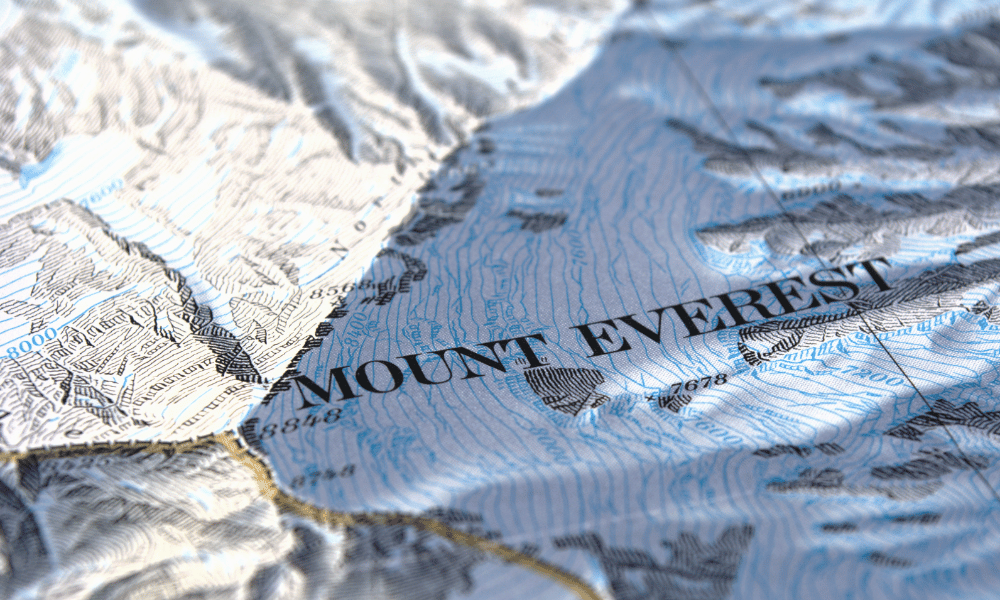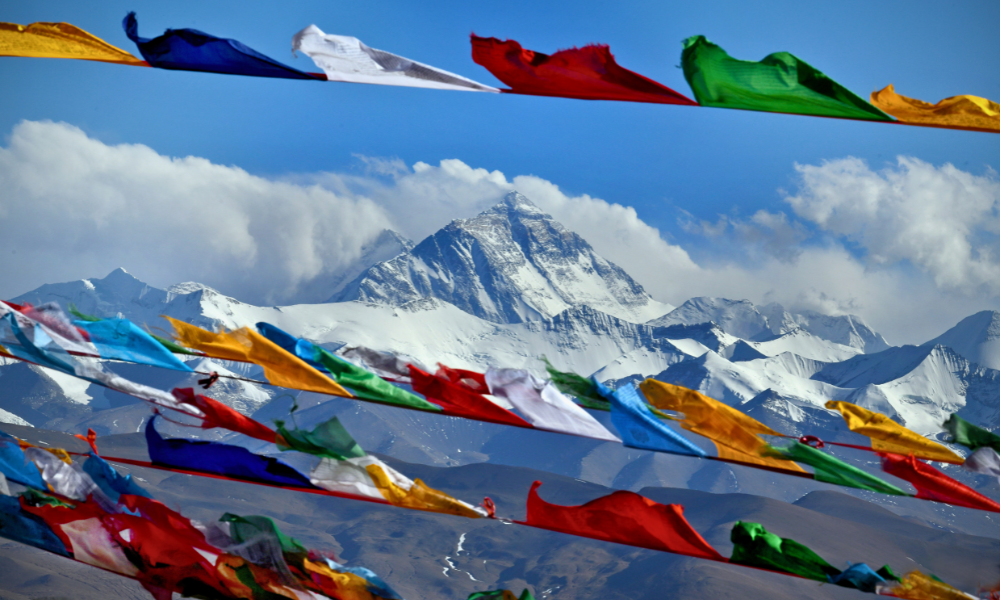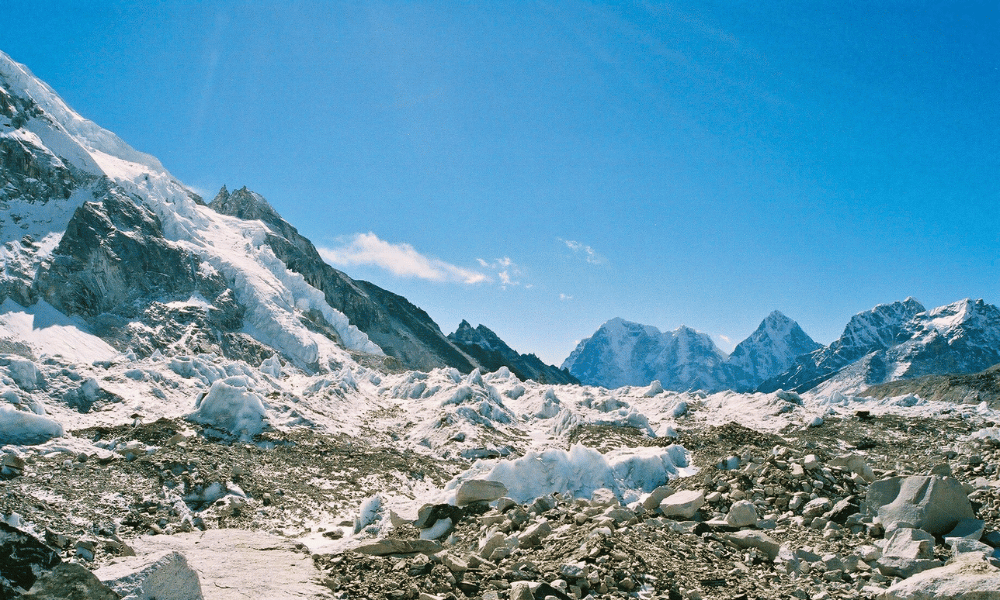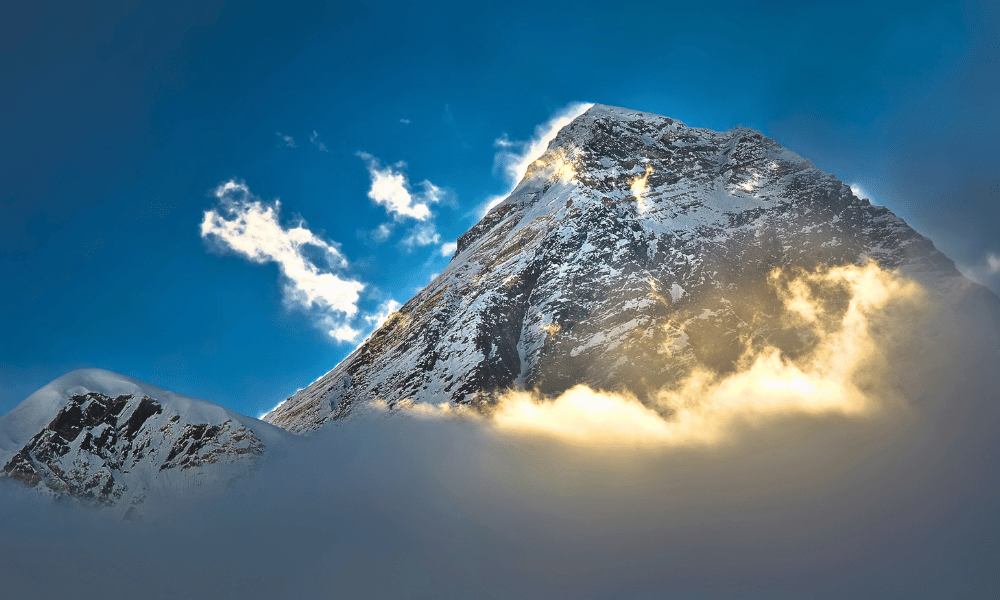Mount Everest Temperature
The weather patterns on Mount Everest are unique, unpredictable, and extreme. They play a pivotal role not only in dictating the mountaineering attempts but also in significantly impacting the local ecosystem.
The weather patterns on Mount Everest are unique, unpredictable, and extreme. They play a pivotal role not only in dictating the mountaineering attempts but also in significantly impacting the local ecosystem.


Perched on the crest of the Great Himalayas, Mount Everest reigns as the highest mountain peak in the world, standing tall at an awe-inspiring height of 8,848.86 meters (29,031.7 feet). This colossal mountain is a part of the Mahalangur Himal sub-range of the Himalayas, straddling the international border between Nepal and the Tibet Autonomous Region of China. The mountain has two main climbing routes, one approaching from the southeast in Nepal, known as the standard route, and the other from the north in Tibet.
The name "Mount Everest" was bestowed upon the peak in 1865 by the Royal Geographical Society upon recommendation by Andrew Waugh, the British Surveyor General of India at the time. The mountain was named in honor of his predecessor, Sir George Everest. However, the mountain has been known by many other names. Locally, in Nepal, it's revered as "Sagarmatha," which translates to "Goddess of the Universe" or "Sky Head." In Tibet, it is called "Chomolungma" or "Qomolangma," meaning "Mother Goddess of the Universe."
Mount Everest holds an iconic status as the ultimate challenge for mountaineers from around the world, and its geographic location exposes it to extreme weather conditions. It is a unique confluence of geographical grandeur, extreme climate, and rich cultural significance, making it an intriguing topic of study and exploration.
The weather patterns on Mount Everest are unique, unpredictable, and extreme. They play a pivotal role not only in dictating the mountaineering attempts but also significantly impact the local ecosystem. The severe cold, fierce winds, and sudden storms can create perilous conditions and make Mount Everest one of the most dangerous places to climb.

Understanding the weather patterns, particularly temperature fluctuations, is critical for climbers as it aids in planning the expedition. The timing of ascent is often tightly linked with weather windows, usually occurring in late spring (May) when the temperatures become relatively mild, and the winds die down. However, even slight misjudgments or unexpected shifts in weather can lead to fatal consequences.
Moreover, temperature influences the state of glaciers and ice falls on Everest. Increased temperatures can accelerate glacial melt, leading to unstable paths and increasing the risk of avalanches. On a broader scale, studying these temperatures and their changes can help us understand the impacts of climate change on high-altitude environments.
Related Read: Everest Death Zone
In this blog post, we'll delve deep into the world of temperatures on Mount Everest. We'll start with an examination of the general temperature patterns observed on the mountain, including the stark differences between seasons and altitudes. Then, we'll explore the multitude of factors that influence these temperatures, such as altitude, solar radiation, wind patterns, and atmospheric pressure.
Following this, we will discuss the significant impact these temperatures have on climbers, sharing real-life examples of how temperature changes have influenced climbing attempts - both successful and tragic. We'll also delve into the effects of these temperatures on the unique flora and fauna that inhabit the Everest region.
Finally, we will discuss how global climate change could potentially alter these temperature patterns, and the implications of these changes. We aim to provide a comprehensive understanding of Mount Everest's temperatures, which is vital for mountaineers, climate scientists, and anyone intrigued by the highest peak of our planet. Stay tuned as we embark on this chilling journey.

Temperature patterns on Mount Everest are characterized by significant shifts throughout the year, with notable variation depending on altitude. The temperatures are almost always below freezing and can drop considerably low, especially during winter and at night. Despite these icy conditions, there is a discernible pattern in the temperature, and it's largely influenced by the change of seasons.
During the summer months, from June to August, Mount Everest experiences its monsoon season. Despite the temperatures being relatively warmer during this period, heavy snowfall and frequent storms make this an unfavorable time for climbing. The base camp temperature can range between -2°C to 10°C (28°F to 50°F) during the daytime, while at the summit, it can hover around -20°C (-4°F).
Winter on Everest, from December to February, brings extreme cold and harsh winds. The temperatures at the base camp can range from -17°C to -20°C (1.4°F to -4°F) and can plunge below -36°C (-33°F) at the summit. Climbing attempts during winter are rare and extremely perilous due to these conditions.
As one ascends Mount Everest, the temperatures steadily decrease. The base camp, situated at an altitude of about 5,364 meters (17,598 feet), experiences relatively mild temperatures compared to the higher reaches of the mountain.

In the middle altitudes, which include Camp II (6,400 meters / 20,997 feet) and Camp III (7,200 meters / 23,622 feet), temperatures drop further. For instance, during the climbing season (April-May), temperatures at these camps can range between -15°C and -5°C (5°F and 23°F).
At the summit, the temperatures are brutal. Even during the warmest part of the year, temperatures at the peak rarely rise above -20°C (-4°F) during the day and can drop to around -36°C (-33°F) or even lower at night.
Understanding these temperatures and their patterns is critical, as they significantly influence climbing strategies, the risk of frostbite and hypothermia, and the overall success of summiting the world's tallest peak. It's also vital for comprehending the unique ecosystem that thrives in this seemingly inhospitable environment.
The temperature at Mount Everest is influenced by a range of factors, the most significant being altitude, sunlight, wind, and precipitation.
Altitude: As the altitude increases, the temperature generally decreases - a phenomenon known as the lapse rate. This is primarily due to the thinning atmosphere and decrease in pressure that reduces the air's ability to retain heat.
Sunlight: The angle and intensity of sunlight can dramatically influence temperatures. Direct sunlight during clear days can lead to surprisingly warm temperatures, even at high altitudes. Conversely, during the night or in the absence of sunlight, the temperatures can plummet rapidly.
Wind: The mountain is frequently subject to strong winds, particularly at higher altitudes. These winds can cause temperatures to feel significantly colder than they are, a phenomenon known as the wind chill factor. During winter and spring, the infamous "Jet Stream" - a strong wind that can reach speeds over 160 km/h (100 mph) - hits the summit, leading to a sharp decrease in perceived temperatures.
Precipitation: Mount Everest experiences heavy snowfall, especially during the monsoon season. This precipitation can lower temperatures, increase the wind chill factor, and create hazardous climbing conditions.

Changes in any of these factors can contribute to sudden and extreme temperature changes on Everest. For instance, a shift in the Jet Stream's position can lead to a sudden onset of severe and freezing winds. Likewise, a change in weather patterns can bring about unexpected precipitation, leading to an abrupt drop in temperature and increased risks of avalanches.
Changes in sunlight due to the time of day or cloud cover can also result in drastic temperature swings. During the day, the intense high-altitude sunlight can cause a rise in temperatures, whereas, at night, the lack of solar radiation leads to a rapid drop in temperatures.
The interplay of these factors makes the weather on Mount Everest highly unpredictable and potentially dangerous, necessitating meticulous planning and continual monitoring during climbing expeditions. Understanding these influences also provides insight into the unique and harsh conditions endured by the flora and fauna native to this region.

The extreme temperatures on Mount Everest pose significant challenges and risks to climbers. The most immediate of these risks are hypothermia and frostbite. Hypothermia occurs when the body loses heat faster than it can produce, leading to a dangerously low body temperature. Frostbite, on the other hand, happens when the skin and underlying tissues freeze, most commonly affecting extremities like fingers, toes, nose, and ears.
Extreme cold can also affect physical performance and cognitive function. Climbers can experience fatigue, impaired judgment, and reduced physical strength, which can increase the risk of accidents and injuries. Moreover, the cold conditions can freeze climbing equipment and food, complicate the preparation of meals, and make sleeping and resting difficult.
Numerous expeditions to Mount Everest have shown how temperature conditions can influence the outcome of a climb.
Successful Attempt: In May 1953, Sir Edmund Hillary and Tenzing Norgay made the first successful ascent to the summit of Mount Everest. The expedition strategically timed their final ascent to occur in a brief window of milder weather.
Unsuccessful Attempt: In contrast, the 1996 Mount Everest disaster, which claimed the lives of eight climbers, demonstrated how swiftly changing weather conditions can lead to tragedy. The climbers were caught in a blizzard near the summit, where temperatures dropped precipitously, contributing to the fatal outcomes.
Experienced climbers and mountain guides emphasize the importance of proper preparation and equipment to cope with the extreme cold. High-quality cold-weather gear, including down suits, layered clothing, insulated gloves, and heated boots, is vital to protect against frostbite and hypothermia.
Additionally, climbers are advised to maintain a steady pace to generate body heat without sweating, as sweat can freeze and lead to rapid heat loss. Regular intake of high-calorie food and warm drinks is also crucial to maintain the body's energy and heat levels.
Mount Everest's extreme temperatures are an inherent part of its challenge. They necessitate not only physical toughness and mental resilience but also careful planning, proper equipment, and respectful awareness of the mountain's potent and unpredictable nature.
Related Read: Everest Rainbow Valley
Mount Everest's extreme temperatures have a significant impact on the local ecosystem, influencing the type of flora and fauna that can survive in such conditions. The region's biodiversity is divided into different zones based on altitude and temperature.
In the lower reaches of the mountain, where temperatures are relatively warmer, the region is home to a diverse array of flora, including forests of pine and hemlock, and numerous species of rhododendrons and juniper. The fauna in these regions include snow leopards, red pandas, Himalayan tahr, and a variety of bird species.

As one moves higher, the vegetation becomes sparser due to lower temperatures, eventually giving way to alpine tundra and then rock and ice. Only the most hardy species, such as the Himalayan jumping spider, can survive at these altitudes.
The temperature changes on Mount Everest, particularly the warming trends associated with global climate change, have serious implications for the region's glaciers. Rising temperatures increase the rate of glacial melting, leading to the formation of dangerous glacial lakes that can cause devastating floods downstream.
These melting glaciers also contribute to rising sea levels globally, a significant concern related to climate change. Additionally, they threaten the availability of freshwater downstream, affecting millions of people who rely on these glacier-fed rivers for their water supply.
Moreover, as temperatures rise, the lower-altitude ecosystems are pushed upward, causing habitat loss for many species and increasing the risk of extinction. Changes in precipitation patterns, another consequence of climate change, can also alter the region's biodiversity.

Understanding these impacts is crucial for developing strategies to mitigate the effects of climate change in the region and protect the unique and fragile ecosystems of Mount Everest.
Climate change, driven by increasing greenhouse gas concentrations in the atmosphere, is causing global temperatures to rise. This warming trend is also evident in the Himalayas, often referred to as the "third pole" due to their extensive ice fields.
Studies show that the Himalayas are warming at a faster rate than the global average, resulting in significant environmental changes. The region has experienced increased glacial melt, altered precipitation patterns, and shifting habitats for flora and fauna.
Climate change could potentially alter the temperature patterns on Mount Everest in several ways. Rising average temperatures could make the mountain's harsh cold slightly less severe, potentially extending the window for climbing expeditions. However, increased temperatures would also accelerate the melting of glaciers and icefalls, leading to more unstable and dangerous climbing conditions.

Warmer temperatures might also lead to more precipitation, particularly during the monsoon season, increasing the risk of avalanches and landslides. Moreover, changes in global wind patterns due to climate change could potentially affect the timing and intensity of the jet stream, making weather conditions on Everest even more unpredictable.
For climbers, these changes could make Mount Everest both more accessible and more dangerous. While potentially milder temperatures might extend climbing opportunities, the increased risk of avalanches, landslides, and unstable paths present significant dangers.
For the ecosystem, these changes could prove devastating. The loss of glaciers and the upward shift of habitats could threaten numerous species with extinction. Moreover, the millions of people who depend on the waters from the Himalayan rivers could face severe water shortages.
As we move forward, it is crucial to monitor these changes and understand their implications. The case of Mount Everest serves as a stark reminder of the tangible and immediate impacts of climate change, urging us to take collective action to mitigate its effects.
Mount Everest, the world's highest peak, presents a unique and fascinating study of temperature patterns and their impacts. From the consistently sub-zero temperatures to the remarkable differences between the seasons and altitudes, the temperature on Mount Everest is both a critical element of its inherent challenge and a significant influencer of its unique environment.
Throughout this blog post, we have explored these temperature patterns in-depth, revealing the multitude of factors that influence them - from altitude and sunlight to wind patterns and precipitation. We've learned how these temperatures, along with the often sudden and extreme changes, pose significant risks to climbers, demanding meticulous planning, proper equipment, and respectful understanding of the mountain's harsh conditions.
We've also seen how these temperatures shape the environment of Mount Everest, dictating the conditions under which its unique flora and fauna can survive, and influencing the state of its glaciers and icefalls.

In the face of climate change, understanding these temperature patterns and their potential alterations becomes even more critical. The rising temperatures and changing precipitation patterns can drastically impact climbing conditions, destabilize the mountain's ecosystem, and disrupt the lives of millions who rely on the region's water resources.
While Mount Everest continues to inspire awe and attract climbers from around the world, it also stands as a potent symbol of the earth's fragility in the face of climate change. The study of its temperatures not only contributes to safer and more successful climbing endeavors but also bolsters our collective understanding of our planet's changing climate - a challenge that calls for our urgent attention and action.
As we continue to gaze upon this majestic peak, may we remember that the lessons we learn from its icy slopes are as significant as the summit itself. From the heart of the Himalayas, Mount Everest beckons us to strive not only for higher heights but also for deeper understanding and greater respect for our extraordinary world.
The Himalayan Database. The Expedition Archives of Elizabeth Hawley. https://www.himalayandatabase.com/
Immerzeel, W. W., et al. (2020). Importance and vulnerability of the world’s water towers. Nature, 577(7790), 364-369.
Krause, P., et al. (2010). The impact of glaciers on the runoff and the reconstruction of mass balance history from hydrological data in the tropical Cordillera Blanca, Peru. Journal of Hydrology, 385(1-4), 131-144.
Bajracharya, S. R., et al. (2014). The status and decadal change of glaciers in the Bhutan Himalaya. The Cryosphere, 8(1), 227-243.
Shrestha, U. B., et al. (2012). Climate change, phenology, and phenological control of vegetation feedbacks to the climate system. Agricultural and Forest Meteorology, 169, 156-173.
Climbing Weather report for Mount Everest. Mountain Forecast. https://www.mountain-forecast.com/peaks/Mount-Everest/forecasts/8850
The Intergovernmental Panel on Climate Change (IPCC) reports and assessments provide detailed scientific information about the current state of climate change and its potential impacts: https://www.ipcc.ch/
NASA's Global Climate Change: Vital Signs of the Planet. This site provides a wealth of information on global climate change, including data, analyses, and articles: https://climate.nasa.gov/
our first-hand Himalayan travel experience